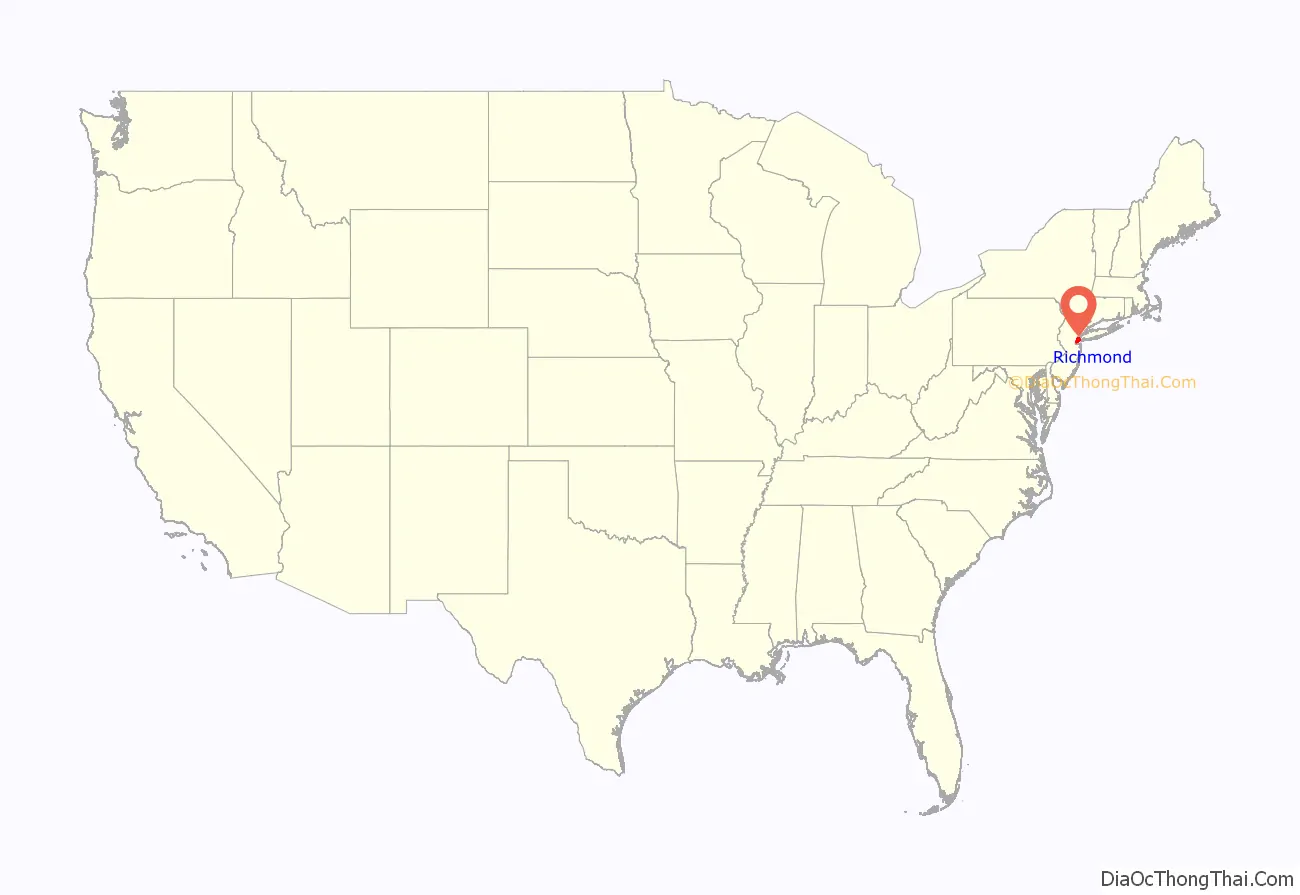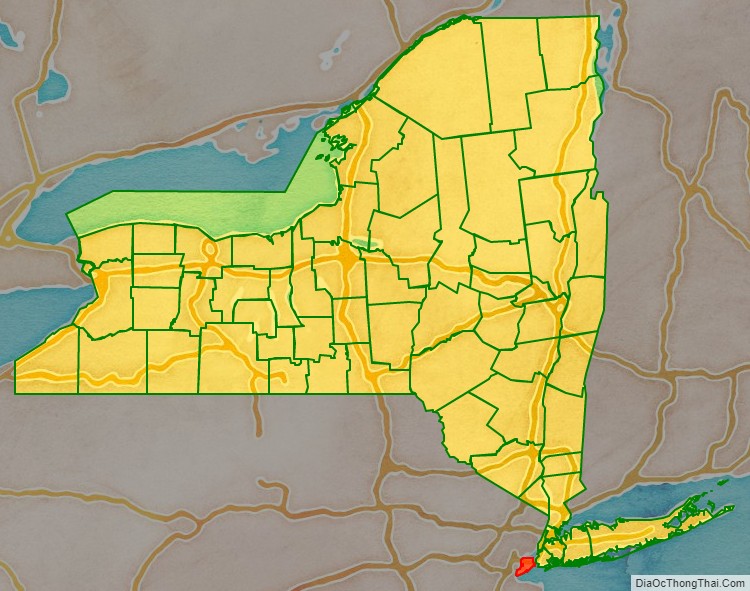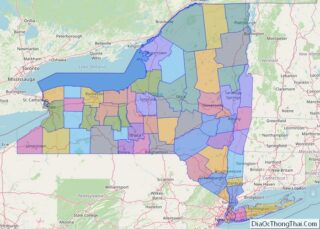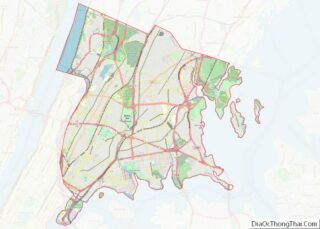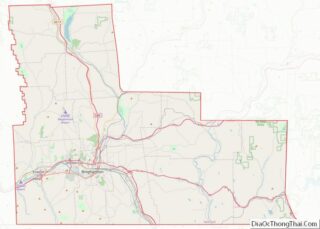Staten Island (/ˈstætən/ STAT-ən) is a borough of New York City, coextensive with Richmond County, in the U.S. state of New York. Located in the city’s southwest portion, the borough is separated from New Jersey by the Arthur Kill and the Kill Van Kull and from the rest of New York by New York Bay. With a population of 495,747 in the 2020 Census, Staten Island is the least populated borough but the third largest in land area at 58.5 sq mi (152 km).
A home to the Lenape indigenous people, the island was settled by Dutch colonists in the 17th century. It was one of the 12 original counties of New York state. Staten Island was consolidated with New York City in 1898. It was formally known as the Borough of Richmond until 1975, when its name was changed to Borough of Staten Island. Staten Island has sometimes been called “the forgotten borough” by inhabitants who feel neglected by the city government.
The North Shore—especially the neighborhoods of St. George, Tompkinsville, Clifton, and Stapleton—is the island’s most urban area. It contains the designated St. George Historic District and the St. Paul’s Avenue-Stapleton Heights Historic District, which feature large Victorian houses. The East Shore is home to the 2+1⁄2-mile (4-kilometer) FDR Boardwalk, the world’s fourth-longest boardwalk. The South Shore, site of the 17th-century Dutch and French Huguenot settlement, developed rapidly beginning in the 1960s and 1970s and is now mostly suburban. The West Shore is the island’s least populated and most industrial part.
Motor traffic can reach the borough from Brooklyn by the Verrazzano-Narrows Bridge and from New Jersey by the Outerbridge Crossing, Goethals Bridge and Bayonne Bridge. Staten Island has Metropolitan Transportation Authority (MTA) bus lines and an MTA rapid transit line, the Staten Island Railway, which runs from the ferry terminal at St. George to Tottenville. Staten Island is the only borough not connected to the New York City Subway system. The free Staten Island Ferry connects the borough to Manhattan across New York Harbor. It provides views of the Statue of Liberty, Ellis Island, and Lower Manhattan.
| Name: | Richmond County |
|---|---|
| FIPS code: | 36-085 |
| State: | New York |
| Founded: | 1683 |
| Named for: |
|
| Seat: | none (sui generis) |
| Total Area: | 102.5 sq mi (265 km²) |
| Land Area: | 58.5 sq mi (152 km²) |
| Total Population: | 495,747 |
| Population Density: | 8,618.3/sq mi (3,327.5/km²) |
| Time zone: | UTC−5 (Eastern Standard Time) |
| Summer Time Zone (DST): | UTC−4 (Eastern Daylight Time) |
| Website: | www.statenislandusa.com |
Richmond County location map. Where is Richmond County?
History
Native Americans
As in much of North America, human habitation appeared on the island fairly rapidly after the Wisconsin glaciation. Archaeologists have recovered tool evidence of Clovis culture activity dating from about 14,000 years ago. This evidence was first discovered in 1917 in the Charleston section of the island. Various Clovis artifacts have been discovered since then, on property owned by Mobil Oil.
The island was probably abandoned later, possibly because of the extirpation of large mammals on the island. Evidence of the first permanent Native American settlements and agriculture are thought to date from about 5,000 years ago, although early archaic habitation evidence has been found in multiple locations on the island.
Rossville points are distinct arrowheads that define a Native American cultural period from the Archaic period to the Early Woodland period, dating from about 1500 to 100 BC. They are named for the Rossville section of Staten Island, where they were first found near the old Rossville Post Office building.
At the time of European contact, the island was inhabited by the Raritan band of the Unami division of the Lenape. In Lenape, one of the Algonquian languages, Staten Island was called Aquehonga Manacknong, meaning “as far as the place of the bad woods”, or Eghquhous, meaning “the bad woods”. The area was part of the Lenape homeland known as Lenapehoking. The Lenape were later called the “Delaware” by the English colonists because they inhabited both shores of what the English named the Delaware River.
The island was laced with Native American foot trails, one of which followed the south side of the ridge near the course of present-day Richmond Road and Amboy Road. The Lenape did not live in fixed encampments but moved seasonally, using slash and burn agriculture. Shellfish was a staple of their diet, including the Eastern oyster (Crassostrea virginica) abundant in the waterways throughout the present-day New York City region. Evidence of their habitation can still be seen in shell middens along the shore in the Tottenville section, where oyster shells larger than 12 inches (305 mm) are sometimes found.
Burial Ridge, a Lenape burial ground on a bluff overlooking Raritan Bay in Tottenville, is the largest pre-European burial ground in New York City. Bodies have been reported unearthed at Burial Ridge from 1858 onward. After conducting independent research, which included unearthing bodies interred at the site, ethnologist and archaeologist George H. Pepper was contracted in 1895 to conduct paid archaeological research at Burial Ridge by the American Museum of Natural History. The burial ground today is unmarked and lies within Conference House Park.
European settlement
The first recorded European contact on the island was in 1520 by Italian explorer Giovanni da Verrazzano who sailed through The Narrows on the ship La Dauphine and anchored for one night.
The Dutch did not establish a permanent settlement on Staaten Eylandt for many decades. Its name derived from the Staten Generaal, the parliament of the Republic of the Seven United Netherlands. From 1639 to 1655, Cornelis Melyn and David de Vries made three separate attempts to establish one there, but each time the settlement was destroyed in conflicts between the Dutch and the local tribe. In 1661, the first permanent Dutch settlement was established at Oude Dorp (Dutch for “Old Village”) by a small group of Dutch, Walloon, and French Huguenot families, just south of the Narrows near South Beach. Many French Huguenots had gone to the Netherlands as refugees from the religious wars in France, suffering persecution for their Protestant faith, and some joined the emigration to New Netherland. At one point nearly a third of the residents of the Island spoke French. The last vestige of Oude Dorp is the name of the present-day neighborhood of Old Town adjacent to Old Town Road.
Staten Island was not spared the bloodshed that culminated in Kieft’s War. In the summer of 1641 and in 1642, Native American tribes laid waste to Old Town.
Richmond County
At the end of the Second Anglo-Dutch War in 1667, the Dutch ceded New Netherland to England in the Treaty of Breda, and the Dutch Staaten Eylandt, anglicized as “Staten Island”, became part of the new English colony of New York.
In 1670, the Native Americans ceded all claims to Staten Island to the English in a deed to Governor Francis Lovelace. In 1671, in order to encourage an expansion of the Dutch settlements, the English resurveyed Oude Dorp (which became known as ‘Old Town’) and expanded the lots along the shore to the south. These lots were settled primarily by Dutch families and became known as Nieuwe Dorp (meaning ‘New Village’), which later became anglicized as New Dorp.
Captain Christopher Billopp, after years of distinguished service in the Royal Navy, came to America in 1674 along with the newly appointed royal governor of New York and the Jerseys Sir Edmund Andros, in charge of a company of infantry. The following year, he settled on Staten Island, where he was granted a patent for 932 acres (3.8 km) of land. According to one version of an oft-repeated but apocryphal tale, Captain Billopp’s seamanship secured Staten Island to New York, rather than to New Jersey: the island would belong to New York if the captain could circumnavigate it in one day, which he did. This story is most likely untrue, due to conflicting information on the time Christopher Billopp took to complete the race and whether he received a personal prize or not. Mayor Michael Bloomberg perpetuated the myth by referring to it at a news conference in Brooklyn on February 20, 2007. Reliable historical documentation of the event is extremely sparse, however, and most historians conclude that it is entirely apocryphal. In 2007, The New York Times addressed the issue in a news article, which concluded that this event was heavily embellished over the years and almost certainly originated in local folklore. YouTube personality CGP Grey addressed the story of the Staten Island race and its historical discrepancies in a 2019 video, in which he concluded that Gabriel Disosway, a local chronicler in Staten Island, was responsible for originating the legend in the mid-1800s.
In 1683, the colony of New York was divided into ten counties. As part of this process, Staten Island, as well as several minor neighboring islands, was designated as Richmond County. The name derives from the title of Charles Lennox, 1st Duke of Richmond, an illegitimate son of King Charles II.
In 1687 and 1688, the English divided the island into four administrative divisions based on natural features: the 5,100-acre (21 km) manorial estate of colonial governor Thomas Dongan in the northeastern hills known as the “Lordship or Manor of Cassiltown”, along with the North, South, and West divisions. These divisions later evolved into the four towns of Castleton, Northfield, Southfield, and Westfield. In 1698, the population was 727.
The government granted land patents in rectangular blocks of 80 acres (320,000 m), with the most desirable lands along the coastline and inland waterways. By 1708, the entire island had been divided up in this fashion, creating 166 small farms and two large manorial estates, the Dongan estate and a 1,600 acres (6.5 km) parcel on the southwestern tip of the island belonging to Christopher Billopp.
The first county seat was established in New Dorp in what was called Stony Brook at the time. In 1729, the county seat was moved to the village of Richmond Town, located at the headwaters of the Fresh Kills near the center of the island. By 1771, the island’s population had grown to 2,847.
18th century and the American Revolution
Staten Islanders were solidly supportive of the Crown, and the island played a significant role in the American Revolutionary War. General George Washington once called Islanders “our most inveterate enemies”.
As support of independence spread throughout the colonies, residents of the island were so uninterested that no representatives were sent to the First Continental Congress, the only county in New York to not send anyone. This had economic repercussions in the months up through 1776, where New Jersey towns such as Elizabethport, Woodbridge, and Dover instituted boycotts on doing business with islanders.
On March 17, 1776, the British forces under Sir William Howe evacuated Boston and sailed for Halifax, Nova Scotia. From Halifax, Howe prepared to attack New York City, which then consisted entirely of the southern end of Manhattan Island. General George Washington led the entire Continental Army to New York City in anticipation of the British attack. Howe used the strategic location of Staten Island as a staging ground for the invasion.
Over 140 British ships arrived over the summer of 1776 and anchored off the shores of Staten Island at the entrance to New York Harbor. The British soldiers and Hessian mercenaries numbered about 30,000. Howe established his headquarters in New Dorp at the Rose and Crown Tavern, near the junction of present New Dorp Lane and Richmond Road. There the representatives of the British government reportedly received their first notification of the Declaration of Independence.
In August 1776, the British forces crossed the Narrows to Brooklyn and outflanked the American forces at the Battle of Long Island, resulting in the British control of the harbor and the capture of New York City shortly afterwards. Three weeks later, on September 11, 1776, Sir William’s brother, Lord Howe, received a delegation of Americans consisting of Benjamin Franklin, Edward Rutledge, and John Adams at the Conference House on the southwestern tip of the island on the former estate of Christopher Billopp. The Americans refused a peace offer from Howe in exchange for withdrawing the Declaration of Independence, and the conference ended without an agreement.
On August 22, 1777, the Battle of Staten Island occurred between the British forces and several companies of the 2nd Canadian Regiment fighting alongside other American companies. The battle was inconclusive, though both sides surrendered over a hundred troops as prisoners. The Americans finally withdrew.
In early 1780, while the Kill Van Kull was frozen over, Lord Stirling led an unsuccessful Patriot raid from New Jersey on the western shore of Staten Island. It was repulsed in part by troops led by British Commander Francis Rawdon-Hastings, 1st Marquess of Hastings.
In June 1780, Wilhelm von Knyphausen, commander of Britain’s Hessian auxiliaries, led many raids and a full assault into New Jersey from Staten Island with the aim of defeating George Washington and the Continental Army. Although the raids were successful in the Newark and Elizabeth areas, the advance was halted at Connecticut Farms (Union) and the Battle of Springfield.
British forces remained on Staten Island for the remainder of the war. Most Patriots fled after the British occupation, and the sentiment of those who remained was predominantly Loyalist. Even so, the islanders found the demands of supporting the troops to be heavy. The British army kept headquarters in neighborhoods such as Bulls Head. Many buildings and churches were destroyed for their materials, and the military’s demand for resources resulted in an extensive deforestation by the end of the war. The British army again used the island as a staging ground for its final evacuation of New York City on December 5, 1783. After their departure, many Loyalist landowners, such as Christopher Billop, the family of Canadian historian Peter Fisher, John Dunn, who founded St. Andrews, New Brunswick, and Abraham Jones, fled to Canada, and their estates were subdivided and sold.
Staten Island was occupied by the British longer than any single part of the Thirteen Colonies.
19th century
On July 4, 1827, the end of slavery in New York state was celebrated at Swan Hotel, West Brighton. Rooms at the hotel were reserved months in advance as local abolitionists, including prominent free blacks, prepared for the festivities. Speeches, pageants, picnics, and fireworks marked the celebration, which lasted for two days.
In the early 19th century, New Jersey and New York disputed the location of their maritime boundary. The original charters were of no help because they were worded ambiguously. New York argued that the eastern edge of New Jersey was located at the Hudson River’s shoreline during high tide, which would give New York control of all the docks and wharves on the Hudson River. New Jersey argued that the maritime boundary should be down the middle of the Hudson River and then continue out to the Atlantic Ocean, which would give New Jersey control of the docks and wharves as well as Staten Island. Vice President Martin Van Buren negotiated a compromise that established the maritime boundary in the middle of the Hudson River and gave Staten Island to New York. Ellis Island and Bedloe’s Island, both uninhabited at the time, also became controlled by New Jersey.
From 1800 to 1858, Staten Island was the location of the largest quarantine facility in the United States. Angry residents burned down the hospital compound in 1858 in a series of attacks known as the Staten Island Quarantine War.
In 1860, parts of Castleton and Southfield were made into a new town, Middletown. The Village of New Brighton in the town of Castleton was incorporated in 1866, and in 1872 the Village of New Brighton annexed all the remainder of the Town of Castleton and became coterminous with the town.
An 1887 movement to incorporate Staten Island as a city ended up resulting in nothing.
Consolidation with New York City
The towns of Staten Island were dissolved in 1898 with the consolidation of the City of Greater New York, as Richmond County became one of the five boroughs of the expanded city. Although consolidated into the City of Greater New York in 1898, the county sheriff of Staten Island maintained control of the jail system, unlike the other boroughs, which had gradually transferred control of the jails to the Department of Correction. The jail system was not transferred until January 1, 1942. Staten Island is the only borough without a New York City Department of Correction major detention center.
The construction of the Verrazzano-Narrows Bridge, along with the other three major Staten Island bridges, created a new way for commuters and tourists to travel from New Jersey to Brooklyn, Manhattan, and areas farther east on Long Island. The network of highways running between the bridges has effectively carved up many of Staten Island’s old neighborhoods. The bridge opened many areas of the borough to residential and commercial development, especially in the central and southern parts of the borough, which had been largely undeveloped. Staten Island’s population doubled from 221,991 in 1960 to 443,728 in 2000. Nevertheless, Staten Island remained less developed than the rest of the city. A New York Times article in 1972 stated that despite the borough having 333,000 residents, parts of the island still maintained a bucolic atmosphere with woods and marshes.
Throughout the 1980s, a movement to secede from the city steadily grew in popularity, notably championed by longtime New York state senator and former Republican Party mayoral nominee John J. Marchi. The campaign reached its peak during the mayoral term of David Dinkins (1990–1993), after the U.S. Supreme Court invalidated the New York City Board of Estimate, which had given equal representation to the five boroughs. Dinkins and the city government opposed a non-binding secession referendum, contending that the vote should not be permitted by the state unless the city issued a home rule message supporting it, which the city would not. Governor Mario Cuomo disagreed, and the vote went forward in 1993. Ultimately, 65% of Staten island residents voted to secede, through the approval of a new city charter making Staten Island an independent city, but implementation was blocked in the State Assembly.
In the 1980s, the United States Navy had a base on Staten Island called Naval Station New York. It had two sections: a Strategic Homeport in Stapleton and a larger section near Fort Wadsworth, where the Verrazzano-Narrows Bridge enters the island. The base was closed in 1994 through the Base Realignment and Closure process because of its small size and the expense of basing personnel there.
Fresh Kills and its tributaries are part of the largest tidal wetland ecosystem in the region. Its creeks and wetlands have been designated a Significant Coastal Fish and Wildlife Habitat by the New York State Department of Environmental Conservation. Opened along Fresh Kills as a “temporary landfill” in 1947, the Fresh Kills Landfill was a repository of trash for the city of New York. The landfill, once the world’s largest man-made structure, was closed in 2001, but it was briefly reopened for the debris from Ground Zero following the September 11 attacks in 2001. It is being converted into a park. Plans for the park include a bird-nesting island, public roads, boardwalks, soccer and baseball fields, bridle paths, and a 5,000-seat stadium. Today, freshwater and tidal wetlands, fields, birch thickets, and a coastal oak maritime forest, as well as areas dominated by non-native plant species, are all within the boundaries of Fresh Kills.
Richmond County Road Map
Geography
According to the U.S. Census Bureau, Richmond County has a total area of 102.5 square miles (265 km), of which 58.5 square miles (152 km) is land and 44.0 square miles (114 km) (43%) is water. It is the third-smallest county in New York by land area and fourth-smallest by total area.
Although Staten Island is a borough of New York City, the island is topographically and geologically a part of New Jersey. Staten Island is separated from Long Island by the Narrows and from mainland New Jersey by the Arthur Kill and the Kill Van Kull. Staten Island is positioned at the center of New York Bight, a sharp bend in the shoreline between New Jersey and Long Island. The region is considered vulnerable to sea-level rise. On October 29, 2012, the island experienced severe damage and loss of life along with the destruction of many homes during Hurricane Sandy.
In addition to the main island, the borough and county also include several small uninhabited islands:
- The Isle of Meadows (at the mouth of Fresh Kills)
- Prall’s Island (in the Arthur Kill)
- Shooters Island (in Newark Bay; part of it is in New Jersey)
- Swinburne Island (in Lower New York Bay)
- Hoffman Island (in Lower New York Bay)
The highest point on the island, the summit of Todt Hill, elevation 410 ft (125 m), is also the highest point in the five boroughs, as well as the highest point on the Atlantic coastal plain south of Great Blue Hill in Massachusetts and the highest point on the coast proper south of Maine‘s Camden Hills. Ward’s Point in the neighborhood of Tottenville is the southernmost point in the state of New York.
Staten Island is the only borough in New York City that does not share a land border with another borough (Marble Hill in Manhattan is contiguous with the Bronx). The borough has a land border with Elizabeth and Bayonne, New Jersey, on uninhabited Shooters Island.
Wildlife
Staten Island is home to a large and diverse population of wildlife. Wildlife found on Staten Island include white-tailed deer (which have increased from a population of 24 in 2008 to 2,000 in 2017 due to a hunting ban and a lack of predators), as well as hundreds of species of birds including bald eagles, turkey, hawks, egrets and ring-necked pheasants. Staten Island is home to Atlantic horseshoe crabs, cottontail rabbits, opossums, raccoons, garter snakes, red-eared slider turtles, newts, spring peeper frogs, leopard frogs, fox, box turtles, skunks, northern snapping turtles and common snapping turtles
Parkland
Staten Island includes thousands of acres of federal, state, and local park land, including the “greenbelt” and “blue belt” park systems and the Gateway National Recreation Area, in addition to hundreds of acres of private wooded areas. The National Park Service maintains full-time wildland firefighters to patrol Staten Island sites in wildfire brush trucks.
The parks on Staten Island are managed by various state, federal and local agencies.
Five sites are part of the 26,000-acre (110 km) Gateway National Recreation Area, managed by the U.S. National Park Service and patrolled by the United States Park Police:
- Great Kills Park
- Miller Field
- Fort Wadsworth
- Hoffman Island
- Swinburne Island
Two New York State parks are managed by the New York State Office of Parks, Recreation and Historic Preservation:
- Mount Loretto Unique Area
- Clay Pit Ponds State Park Preserve
New York State Park Police officers patrol these parks and the surrounding streets.
359 acres (145 ha) of State Forests, state wildlife management areas and Wetlands are managed by the New York State Department of Environmental Conservation:
- Saint Francis Woodland
- Butler Manor Woods
- Arden Heights Woods
- Todt Hill Woods
- North Mount Loretto State Forest
- Lemon Creek Tidal Wetland Wildlife Management Area
- Blosers Wetland Wildlife Management Area
- Goethal Pond Wetland
- Bridge Creek Tidal Wetland
- Old Place Creek Tidal Wetland
- Oakwood Beach Wetland
- Sharrots Shoreline Natural Resource Area
- Sawmill Creek Wetland
The 359 acres (145 ha) of NYS Department of Environmental Conservation land throughout the island are patrolled by New York State Department of Environmental Conservation Police officers and one NYS DEC Forest Ranger, who has the dual task of law enforcement and fire suppression.
The New York City Department of Parks and Recreation manages 156 parks, including:
- Conference House Park
- Willowbrook Park
- Graniteville Quarry Park
- Silver Lake Park
- Clove Lakes Park
The Fresh Kills Landfill was the world’s largest landfill before closing in 2001, although it was temporarily reopened that year to receive debris from the September 11 attacks. The landfill is being redeveloped as Freshkills Park, an area devoted to restoring habitat. The park will become New York City’s second largest public park when completed.
Adjacent counties
- Hudson County — north and northeast
- Union County — northwest
- Middlesex County — west and southwest
- Monmouth County — south
- Kings County — east
- New York County — northeast
